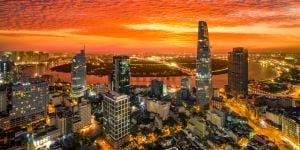
The rapid shift in work structures, accelerated by the pandemic, has given rise to a new breed of adventurers: the digital nomads. This new generation of nomads is making headlines with their unconventional lifestyles. But who exactly are these modern expatriates, and what defines their diverse work styles?
The digital nomad profession
In 1997, Dr. Tsugio Makimoto, a prominent figure in Japan's semiconductor industry, penned the book "Digital Nomad." Coined as "Mr. Semiconductor," Makimoto envisioned a future where technological advancements would liberate individuals from the constraints of traditional office environments. Digital nomads, the embodiment of this vision, are highly mobile workers who require only a computer and internet connection to thrive. Remote work or freelancing (mostly freelance) defines their work style. As they travel extensively, they redefine the work-life balance, prioritizing flexibility and well-being. Digital nomadism is more than just a passing trend; it's a transformative lifestyle choice.
According to Demandsage, a data reporting agency catering to businesses, the global digital nomad population was estimated at 35 million by 2023. Nearly half of these nomads belonged to the thirty-something age group and were typically childless. The overwhelming majority (83%) were self-employed, highlighting the natural synergy between digital nomadism and an entrepreneurial spirit. Interestingly, these entrepreneurs are pretty dedicated, with over two-thirds working at least 40 hours a week. Notably, the digital nomad community encompasses a diverse range of professions, often extending beyond the initial association with the digital realm.
Who are these digital nomads?
Content creators
Travel bloggers are the quintessential digital nomads, but the category extends to professionals specializing in various fields, like food or sports blogging. The nomadic lifestyle perfectly suits their needs, allowing them to travel the world while pursuing their passion. Digital nomad visas offer them the flexibility to seamlessly blend travel with their careers.
Wordsmiths
Journalists and web editors are a perfect fit for the digital nomad model. They can effortlessly combine travel with writing for a diverse international clientele. In fact, these professions rank highly among digital nomads, particularly web editors. Other writing-related fields, such as translation, transcription, and proofreading, also fit well in this work style.
Creative souls
The digital nomad lifestyle embraces a wide spectrum of artists, from photographers and graphic designers to painters, illustrators, and writers. The world becomes their muse, with borders dissolving to foster connections with local communities and fellow artists. This nomadic experience enriches not only their portfolios but also their professional networks. Artists have the freedom to tailor their travels around inspiring events like festivals.
Digital gurus
This category encompasses the quintessential digital nomad professions: community managers, web developers, mobile app developers, webmasters, SEO consultants, marketing specialists, motion designers, communications managers, and web partnership managers. The ever-expanding list of digital professions presents many opportunities for the mobile workforce. Interestingly, tasks traditionally confined to agencies, such as website maintenance or marketing and communications consulting, can now be performed entirely remotely.
Educators and coaches
Just a few years ago, the idea of being a digital nomad teacher, trainer, or coach seemed far-fetched. However, the surge in online training has empowered these professionals to establish themselves as mobile knowledge providers. They can build international client bases while immersing themselves in the cultures of different countries. Their travel experiences can even be woven into their content to enhance its value. HR managers and chartered accountants are also starting to explore the possibilities of digital nomadism.
Social media influencers
Rounding out this (non-exhaustive) list are the digital nomad influencers, the new social media celebrities. While their specific niches can vary—travel bloggers, web editors, cartoonists, musicians, or coaches (health, well-being, international relocation, etc.), they all share the potential to become influencers. The key differentiator lies in how they leverage their work for media exposure. A food blogger with a significant client base can thrive without necessarily being an influencer. Influencers, on the other hand, capitalize on their personal brand (themselves) and their audience size (number of followers) to drive growth. This profile enjoys high visibility, particularly on social media platforms.
Beyond professions: The different rhythms of digital nomadism
Another classification system focuses not on professions but on the work-life patterns of digital nomads. Three distinct profiles emerge:
Occasional profile
The occasional digital nomad works from abroad for a few weeks or months each year. This approach aligns well with traditional employment, as an increasing number of companies are allowing their staff to work remotely for brief periods annually. Prioritizing well-being has entered the workplace, and providing opportunities for occasional remote work helps companies retain their skilled workforce. It's also a win-win situation for employees, making it easier for them to consider starting a family or investing in home-ownership.
Part-time profile
With this type of profile, digital nomadism extends beyond three months a year. These individuals take advantage of the digital nomad visas offered by many countries, which typically grant a one-year visa, renewable or not. Usually, these workers embark on journeys lasting less than a year, allowing for the possibility of a permanent move to the host country or to another later on. For them, these intervals between two expatriations are not only essential professionally (to sustain a profitable business) but also personally: the need to reconnect with loved ones, return home, and the desire to establish a family life, among other considerations.
Full-time profile
Full-time digital nomads view their professional approach as a way of life. For them, authentic digital nomadism entails embracing a nomadic lifestyle, not just residing in expatriate communities but actively participating in local life. They willingly take on the challenge of family life, aiming to show that it's possible to integrate digital nomadism with relationships and children. When facing challenges, such as raising children, they adopt the educator role. On the other hand, some digital nomad couples find the adventure more straightforward when it's just the two of them. They prefer not to impose their lifestyle on their children and wait until the kids are older before considering returning to the nomadic life.
Can you be an eco-friendly digital nomad?
While the younger generation is more environmentally conscious, they are also more inclined to become digital nomads. Can digital nomadism and ecological values coexist? It seems possible for those concerned. They identify with minimalism due to their lifestyle – their possessions are limited to what fits in their suitcase. Accumulating tons of objects is impossible for them. Their lives are condensed into 23 or 46 kilograms, not to mention the carbon footprint generated by frequent round-trip flights.
The consumption habits of these digital nomads are also under scrutiny. Instead of seeking a lifestyle in harmony with nature, they often find themselves influenced by hashtags and content on platforms like Instagram and TikTok. To boost their purchasing power, they often choose less affluent countries, yet they might remain largely unaware of the realities faced by the local populations in the places they visit. This dynamic has, in some cases, led to tensions, as seen in Mexico and Portugal. The consequences of this new form of tourism-work can be quite significant.
However, there are alternatives. Slow tourism is gaining popularity within the digital nomad community. Opting for trains and/or boats over planes, reevaluating itineraries to avoid overly distant destinations, actively supporting the local economy in various aspects (accommodation, consumption, etc.), and steering clear of areas already saturated with foreigners are just a few examples. Digital nomads are already embracing this fresh perspective on their way of life, marking the beginning of a new revolution in digital nomadism.
The bottom line
The rise of digital nomadism represents a significant shift in the way we work and live. With a diverse range of profiles and work styles, digital nomads are redefining the concept of a career and work-life balance. While challenges remain, particularly regarding environmental impact, the potential for a more sustainable and responsible approach to digital nomadism is emerging. This new way of living and working is likely to continue evolving and influencing the future of work.




















Comments